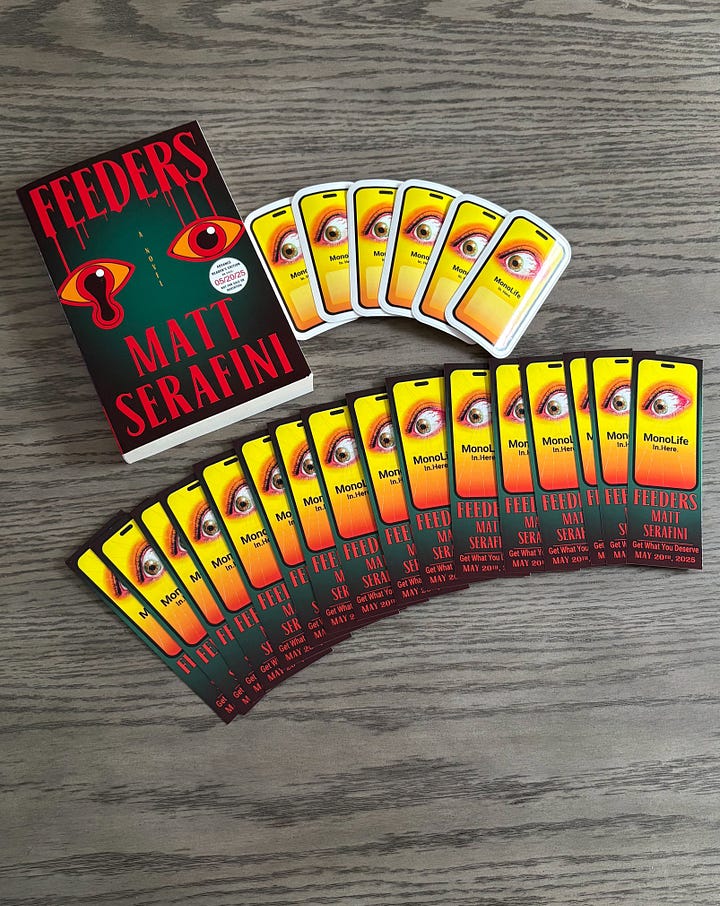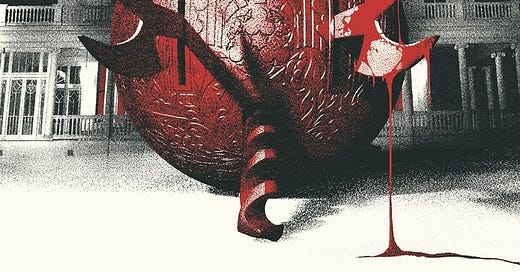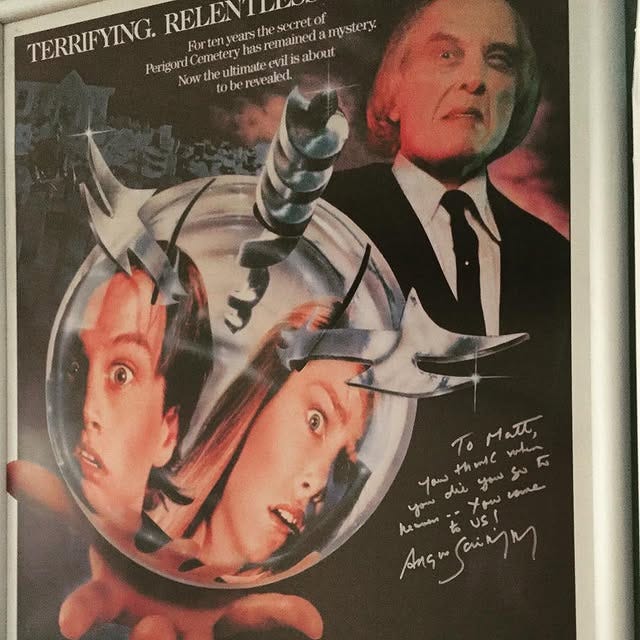PHANTASM'S PHICTION
Reviewing Don Coscarelli's PHICTION and looking at all the ways it compliments his long-running PHANTASM series.
Phiction by Don Coscarelli is a collection of short stories set within the writer/director’s Phantasm universe. I’m not sure why it took me almost a year to get around to reading it, but now that I have, two things are clear:
Don writes superb prose! I hope he’ll write more of it, may it be a follow-up to this, or anything else he’d like to write.
The Phantasm series, to me, has always been about the loss of innocence against the specter of death. Phiction drives this home in a number of ways. While its six stories are varied they are all tales of loss, grief and, perhaps most importantly, perseverance.
Just like the films themselves.
1979’s Phantasm is unique. There is no other film remotely like it, from its setting and mood, to its core of lovable heroes and equally unforgettable monsters. It sits comfortably among my all-time favorite films for all that and its strange beauty too, crescendoing with an emotional twist that asks its viewer to reconsider everything that came before:
Did it really happen? Or were the events of Phantasm all inside the mind of a grieving boy?
That is the question. Well, one of many. And it is that ambiguity, a tapestry of mysteries, that keeps fans returning—and debating—the series. So much of my movie-watching life has been spent combing through Phantasm for answers and theories and one of my fondest teenage memories is when a friend (Hi, Joe) got a copy of the laserdisc extras on VHS (this was long before the MGM DVD) and we sat slack jawed, combing through every last supplement for hints.
Those were the days.
Anyway, come to Phantasm for its unforgettable imagery, whether that is the sinister Tall Man (Angus Scrimm) hoisting a coffin into the back of a hearse by himself, or the infamous flying silver sphere drilling into the brain of the poor bastard who happens to get in its way (more on him later, as he’s the beneficiary of a Phiction story). Maybe enjoy Phantasm for those insidious shrunken Lurkers and the interdimensional portal they’re shuttled off to. If you’re really hip, you’re on board for Reggie and Jody performing this bop:
If Phantasm were only these things, it would still be cemented as a staple of essential 70s cinema. But as discussed, it’s the film’s spirt and soul that turns an iconic piece of horror into a surprisingly potent exploration of mortality and grief.
It’s all spurred by the possibility of the story existing inside the head of its thirteen year old protagonist, Mike Pearson (A. Michael Baldwin). When at the end the Tall Man suffers his demise by slipping into an abandoned mineshaft, Mike awakens to the possibility that everything was a dream. Characters who we saw die are suddenly alive while those who survived are now dead. And it turns out that young Mike is not struggling to accept the loss of his parents, but instead the untimely passing of his older brother, Jody (Bill Thornbury) who now seems to have died in a tragic car accident.
But wait…Jody was alive one scene ago.
What happened?
To take Phantasm at face value, you can argue that the Tall Man represents Mike’s grief-stricken delusion and that each time he appears is a moment when the boy lapses back into said grief. Only problem is that nothing in Phantasm suggests it should be read at face value. Instead, embrace its surreal nature. Understand that its “truth” is a gauzy reality that exists neither in one world or another but somewhere on that plain in between dreams and consciousness.
That is, after all, where Phiction exists. Six stories, taken from every corner of the Phantasm world. Those hoping Coscarelli will provide answers to all the longstanding questions surrounding his films may be disappointed, but I think every Phantasm fan will find the spirt of the series alive and well within these pages. While Phiction isn’t a sequel in any sense, it does continue to evolve the saga in a number of intriguing ways while also and perhaps, most importantly, harkening back to what makes these movies so special…
First up is “Life and Death in the ‘Nam.” It follows an enlisted Reggie in Vietnam in 1968 as he heads out on the town for some R n’ R with a superior officer named Wooten when their getaway explodes into violence. It’s the preamble to a longer stretch of story that sends Wooten and Reg into to bush where the corporal is tasked with assassinating a high value target (and Reg serving as his spotter). The mission goes awry and things veer into an unexpectedly supernatural direction (yes, even for Phantasm, this is a strange one). Ultimately, much like the original film, it’s a story about the loss of innocence (this time Reggies’s) and how that trauma (for lack of a better world) shapes us.
It’s a great story. Coscarelli evokes a strong sense of setting and place without getting bogged down, and he even illustrates proficiency for weapon detail—the kind of thing we writers are often raked over the coals for should we get any of those elements wrong.
One of the things that can be difficult with respect to multimedia IP is capturing the same voice/tone of a character across various formats. Coscarelli succeeds in this story and in all others, too. The way he writes Reg is authentic to Reggie Bannister’s portrayal of the character and it makes you realize Don could continue his franchise as a series of full-tilt novels were he inclined to do so.
Next up is “Behind the Mortuary Door” and it might be the best story in the collection. Coscarelli doesn’t confine himself to one particular writing style, switching gears to deliver a second person narrative in which the main character is the ill-fated mortuary groundskeeper from the original film.
This guy:
What could’ve been filler, a simple and tossed off story about a superfluous character, is instead a compact and chilling tale of invasive evil. How mundane most wickedness is in the beginning. This groundskeeper, we learn, worked for the family-owned Morningside Mortuary his whole life, but things are changing. The funeral home is suddenly under new management and this story is dedicated to the dread and uncertainty that accompanies any merger: vanishing personnel, shifting priorities, hostile bosses (in this case, The Tall Man who makes a brief but creepy and memorable appearance).
It’s unsettling because Coscarelli hones our daily anxieties (I’ve actually been through corporate mergers more terrifying than this one) and while you can appreciate this as a prequel to the first film, offering a snapshot of how Mike and Jody’s hometown first fell victim to the insidious presence of the Tall Man, it’s the scariest story in this collection for other reasons entirely:
The caretaker’s life has suddenly become unrecognizable to him: Having everything you know taken from you. Your job being only part of it. There’s also the prolonged sickness and eventual loss of a loved one (and since this is Phantasm, one guess as to how that turns out). It’s about the horror that comes from realizing everything you once knew is gone.
What is scarier than that?
Later Phantasm movies revel in a more sweeping range of undead chaos, the horrors described in this story becoming amplified as the Tall Man’s terror expands to include entire towns being hollowed out. In a logistical sense, it is interesting to zoom in and watch the beginnings of that phenomenon from a unique perspective. And once you’ve read “Behind the Mortuary Door” and then revisit the film, you’ll find this character’s scenes flush with a new angles of creepiness and intrigue, none of which were there before.
In some ways that’s the best compliment I can give Phiction regarding this story and all its others. With this book, Coscarelli enhances his world, somehow injecting new possibilities without ever spoiling the mysteries that exist (and thrive) at the franchise’s core.
It’s never over…
Coscarelli treats each Phantasm as an essential chapter in the series. I’ve always loved that there doesn’t seem to be a black sheep among them (and there certainly isn’t where I’m concerned). As such, Coscarelli dedicates a welcome number of Phiction’s pages to the evolving roster of supporting characters and in each case it’s good to see them again.
To fanboy out for a moment, I was sort of hoping to find a story dedicated to Phantasm II’s Liz Reynolds. Her psychic bond with Mike is among the franchise’s most intriguing possibilities. A character who seems to inherit some of Mike’s residual terror, awakening in nightly cold sweats, rushing to her stove to check for gas leaks—a reaction to Mike and Reg’s narrow escape from the Pearson house in the opening moments of Phantasm II. Liz also has a notebook stuffed with obsessive scribbles dedicated to her inherited fear of The Tall Man—whom she suspects will be coming for her with the passing of her ailing grandfather.
I mention the character of Liz to illustrate the possibilities of the Phantasm universe. There are several stories untold and it is perhaps the only long-running franchise in which I believe there exists the organic potential for future exploration, no matter the medium.
While not overtly similar, Phantasm as a series reminds me an awful lot of Stephen King’s The Dark Tower, both sagas occupying similar dreamscapes of shifting realities, none of which are necessarily “fake” or “incorrect.” Just alternate. Some day I’ll write a piece on how recasting Mike with James LeGros in Phantasm II works perfectly in this regard…
Anyway, often the potential to continue a series past its sell-by date is illusory, with franchises becoming played out rather quickly. But not here. And it’s through Phiction that Coscarelli kind of proves that long-gestating thesis of mine. To borrow one of the most well-known lines from The Dark Tower, “there are other worlds than these.”
And so in Phiction we reach “The Rocky Road,” a sprawling road trip adventure that feels at times like something out of the early pages of The Stand, before the world goes to literal hell. Here we follow Phantasm III’s Rocky, freshly discharged from the military and on her way home to Alabama to see her folks. Doesn’t take long for things to get complicated, though, a couple of low level thugs have taken control of her daddy’s garage, but that turns out to be the least of her problems as her parents are actually missing…
Coscarelli is adept at fleshing out Rocky in a number of ways, but there’s one especially resonant bit early on dedicated to her first love—a fellow military enlist who died in Desert Storm. There are times throughout Phiction where I wished Coscarelli had spent a little more time on a particular scene or moment, but one of his strengths as a prose writer is his ability to say a lot without having to say too much. Hard to describe how that works as there is no blueprint for doing so effectively, it either succeeds or it doesn’t and he pulls it off here. There isn’t a ton of page space dedicated to Rocky’s inner thoughts, but the present emotional beats strike an effective cord.
Set around the same time in series continuity is “He was Home Alone,” a story focused on Phantasm III’s Tim. For those who may not recall, he’s the eleven-year-old boy who in the film speedran an r-rated version of Home Alone, slaughtering a trio of would-be looters before settling into friendship with our belabored ice cream vendor by trade.
This one kicks off in the aftermath of The Day (what Tim refers to as the moment The Tall Man first rolled through his town like a plague). With his folks gone, Tim hunkers down in his home, ducking patrolling hearses and insidious humans—those on the prowl, looking to exploit the most vulnerable survivors. Tim befriends a young girl kidnapped by a couple of those wretched humans and for a while it’s a play date in the apocalypse. But of course the Tall Man’s minions are still on the loose, on the hunt, and looking to make life complicated for all survivors…
Neither Rocky nor Tim have been seen in any substantive way since the mid 90s (though Rocky has a brief-but-welcome cameo in Phantasm Ravager). Still, Coscarelli is able to summon their spirits as if no time has passed. It’s kind of a miracle. I remember first renting Phantasm III as a new release as a sophomore in high school, meeting these characters for the first time. Over thirty years have passed since then. I’m a dad now and yet, these characters exist in much the same way as when Coscarelli first found them.
Together these stories work within the heart of the series, which is to say, characters finding their inner strength in the wake of personal loss. Both Rocky and Tim, like Reg in the ‘Nam, find their lives turned upside down but there’s a reason Coscarelli binds these characters, turning them into uniquely formidable foes for The Tall Man. It’s their perseverance. At one point in her story, Rocky even acknowledges life’s push and pull, how the secret to it all is finding happiness alongside your misery—a philosophy that really gets to the heart of it. Tim hits a little different, his childish tenacity proving to be a gift as he navigates the apocalypse with resiliency both brutal and innocent (like the way kids will smack each other over snacks and/or the television remote and then sit and play as if nothing bad ever happened). I’d love to pick up with Tim as an adult and see how (if?) he’s managed to weather the proverbial storm.
What’s more is that these two stories nicely compliment the first few Phantasm sequels. Just as Rocky and Tim keep on fighting, the movies found Mike and Reg on the road in true 80s fashion, armed to the teeth and looking to do some righteous damage. Phantasms II and III grew the mythos to encompass a more outwardly threat—the Tall Man becoming more than a nightmarish specter but a bold villain bent on desecrating every small town in America, keen to harvest its endless supply of the dead. While Phantasm on the whole stands as a gruesome reminder of death’s advance, these characters contend with those vanished communities, literal ghost towns that symbolize and serve as our faded memories—a creepy manifestation of the way mortality erases more than life, warping our own memories of departed loved ones and the places that once held them.
To get any more literal is to be bogged down in ridiculous rules and/or logistics—the kind Coscarelli has wisely resisted. Instead, his metaphor shines in the movies and in Phiction—these characters and their Sisyphean struggle against an unbeatable foe. Not the Tall Man. Not really. But death itself.
I think The Tall Man put it best when he signed my Phantasm II poster (I may have asked him to quote that film):
“You think when you die you go to heaven? You come to us!”
Phantoms and apparitions
If death is a specter that hovers over us while reshaping the way we remember those who’ve passed, then Phantasm also explores this concept in more insular ways.
For example, Phantasm III revisited the character of Jody—Mike’s older brother—though arguably only as a figment of Mike and Reggie’s imaginations. Big brother and oldest friend reborn as a phantasm. An illusory image that also occupies the sinister form of…
A silver sphere.
Don Coscarelli was wild for this, as the kids might say.
Jody’s return feels like a perversion of Mike’s memories…like all those ravaged towns. It’s the way death warps everything we hold dear, casting long shadows over our brightest moments. Like that bittersweetness that accompanies our warmest and fuzziest memories of those no longer with us.
It’s in that sense that Phiction gives us a story called “Tobe,” a very short work that exemplifies our inability to go home again. Just as Jody may look like Jody, but in fact is not Jody anymore, so too does the town of Morningside begin to feel like someplace alien for one of its former residents.
In his author’s note, Coscarelli refers to “Tobe” as Phantasm’s Rashomon and the narrative revisits events of the first film from the perspective of a minor character you may or may not remember—Jody’s preppy pal who has maybe thirty seconds of screen time.
Tobe is in town for the funeral that opens the film. The “suicide” of his high school buddy Tommy (that’s the guy stabbed in the opening scene). But Tobe doesn’t feel right about being back in his old stomping grounds. It’s the idea of no longer belonging to a place you were once so familiar with. Like visiting Mom and Dad and realizing your old room feels tiny and constricting.
For Tobe it’s even worse than that, of course. His hometown feels awkward and unwelcoming with sinister vibes simmering beneath the surface. He’s just dying to get out.
Which is when he discovers that he can’t.
As in, he literally cannot.
Each time Tobe hits the highway, he blacks out and awakens elsewhere in town. In his increasingly frantic efforts to escape, he encounters some of the more surreal moments from the first film and it’s a story that defies explanation, making it maybe the truest any of these tales come to recapturing the ‘anything goes’ spirit of the original Phantasm.
Nothing makes much sense here, right down to some of Tobe’s baffling decisions, but that’s a feature, not a bug, as those dreamlike qualities are among the franchise’s most intrinsic characteristics.
As Tobe comes to accept that home is no longer home, so too does Mike begin to realize that death cannot be beaten, only accepted. In Phantasm Oblivion, the fourth film in the series, Mike’s story comes to a close with his decision to face the Tall Man alone. It reflects his shift toward acceptance, realizing that firepower is futile in a fight against the inevitable (death).
Oblivion is the last of the films to be directed by Don Coscarelli and it feels like the true climax of the series. It concludes with an alternate take/deleted bit cut from the original film, Reggie and Mike in the ice cream truck, a quiet drive at night bolstered by a strange sense of calm (acceptance). Mike’s closing lines (“it’s just the wind”) bring the series full circle. Either young Mike has finally accepted the passing of his brother and will at last go on to have a peaceful life, or he’s evaded the Tall Man and his soul has at last reached the after life. No matter the interpretation, the series had drawn to a finish that’s as moving as anything the genre has attempted.
And yet, there is one more film in the series: Phantasm Ravager. It’s not unwelcome. Every great story deserves an epilogue and Ravager proves an effective coda. For the first time, there is an unambiguous shift to Reggie as the main character. Unlike Mike, he hasn’t yet accepted his fate (and maybe there’s a reason for that). As such, we follow Reg through a kaleidoscope of varying realities: still on the world’s strangest road tip, then plunged far into the future where he’s part of an ongoing battle against the Tall Man in a post-apocalyptic wasteland, and lastly as a dementia patient wilting away in a nursing home.
Have Reggie’s adventures truly evolved into a post-apocalyptic battle where old friends and acquaintances are forever by his side, or is this all just a dying man’s fantasy?
Why not both?
Death is, after all, both an apocalypse and a quiet fade. While Mike has faced down his fear and gone back to boyhood (where we last saw him at Oblivion’s end), Reggie hasn’t accepted the inevitable, and is determined to keep fighting against it. Who’s to say Ravager’s versions of Mike aren’t figments of Reggie’s mind?
So at the end when Reg chooses to join his pals Mike and Jody in a modified Cuda for one final ride down the highway, speeding off into a sphere-laden sunset, well, it is perhaps a fitting way to leave a character who first learned back in the ‘Nam that you gotta fight to survive.
Also fitting, then, that the final Phiction story belongs to one of Ravager’s supporting characters, the smart-mouthed and ready-to-brawl little person, Chunk. The story is “Escape from New York” and it’s kind of cool to spend some time inside of an epic scale version of Phantasm. I won’t get into all the bigger budgeted sequels that might’ve happened throughout the years, but the beginning of this story definitely feels inspired by the most grandiose of them.
Here, we follow Chunk as he navigates the start of what’s called the Orbital invasion, and whether you want to theorize that this apocalyptic scenario exists only in one of Phantasm’s more overtly sci-fi dimensions, or as some far off future that can’t be prevented, it’s when the Tall Man’s evil manifests as a plague spreading into the cities, laying waste to civilization as his massive silver spheres roam the skies, decimating the cityscapes.
Chunk flees New York and discovers that humanity has already succumbed to its worst instincts. Instincts that, Coscarelli shows, Chunk is quite familiar with due to his bullied childhood. Because fate is strange, he winds up the custodian to three orphaned children, and as they explore the countryside, they discover that the most severe evil isn’t the Tall Man or his minions.
It’s interesting to see another side of the Phantasm world, through the eyes of one of its most recent characters, with a total change of scenery (the east coast), and with zero ties to anyone from the vintage films. And yet it all works inside the coda that is Phantasm Ravager: Chunk, like Reg, like the other companions chronicled here, find purpose in the fight.
As Ravager shows, perhaps ongoing resistance to the Tall Man is what really grows the strength of their foe, because the longer you put off death’s advance, the more inevitable it becomes.
Phantasm invites endless theories: Is the Tall Man an alien? A grim reaper? A figment of trauma? Explanation only dulls its potency and I’m glad Coscarelli uses Phiction to compliment, rather than explain, the series.
The movies and this new short story collection reflect the complexity of our mortality and it’s only when we let go of literal interpretations that we’re able to locate Phantasm’s actual purpose as a mirror to our own understanding. Where the only certainty is that we’ll never fully be able to comprehend mysteries of life and death.
But that we’ll never stop trying, either.
Get yourself a copy of Phiction right here.
Housekeeping
Thank you for reading all the way down! Just a reminder that my novel Feeders releases in just under two months!
It’s coming through Simon & Schuster’s Gallery Books on May 20—available in paperback, ebook and audio!
Please pre-order it today!


And once you’ve done so, you can reply to this email with proof of order and a mailing address and I’ll send you a signed bookplate and bookmark (seen in the photo above).
I’ll be back with more news real soon.








L